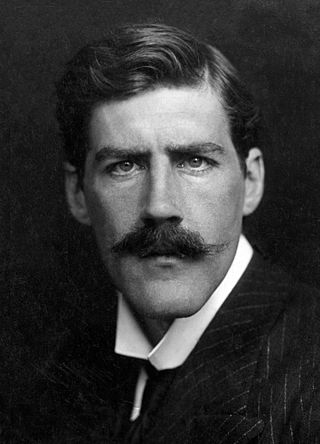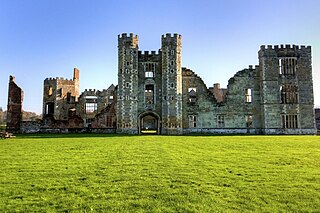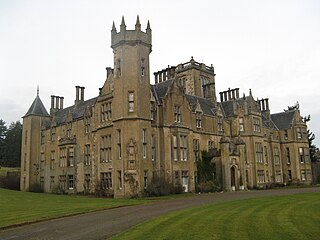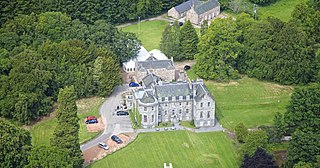
David Alexander Edward Lindsay, 27th Earl of Crawford and 10th Earl of Balcarres,, styled Lord Balcarres or Lord Balniel between 1880 and 1913, was a British Conservative politician and art connoisseur.

Cowdray House consists of the ruins of one of England's great Tudor houses, architecturally comparable to many of the great palaces and country houses of that time. It is situated in the parish of Easebourne, just east of Midhurst, West Sussex standing on the north bank of the River Rother. It was largely destroyed by fire on 24 September 1793, but the ruins have nevertheless been Grade I listed.

James Ludovic Lindsay, 26th Earl of Crawford and 9th Earl of Balcarres, KT, FRS, FRAS was a British astronomer, politician, ornithologist, bibliophile and philatelist. A member of the Royal Society, Crawford was elected president of the Royal Astronomical Society in 1878. He was a prominent Freemason, having been initiated into Isaac Newton University Lodge at the University of Cambridge in 1866.

The park lies in the South Downs National Park. The estate belongs to Viscount Cowdray, whose family have owned it since 1909. It has a golf course, and it offers clay pigeon shooting and corporate activity days, as well as the more traditional activities of agriculture, forestry and property lets.

Dunecht is a slightly linear village on the A944 road in north-east Aberdeenshire in Scotland. It is not to be confused with Echt.

Crimonmogate is an estate near Crimond, Aberdeenshire. The estate formed part of Lonmay parish, dates back to the 14th century, and was included in the lands owned by the powerful Earls of Erroll. The estate was sold by Mary Hay, 14th Countess of Erroll, in the 1730s.

John Smith was a Scottish architect. His career started in 1805 and he was appointed as the official city architect of Aberdeen in 1807, the first person to hold this post. Together with Archibald Simpson, he contributed significantly to the architecture of Aberdeen, and many of the granite buildings that gave the city the nickname "The Granite City" or also "The Silver City" are attributed to them.
The Dunecht Estate is one of the largest private estates in Aberdeenshire, Scotland at 53,000 acres (210 km2). It is owned by The Hon Charles Anthony Pearson, the younger son of the 3rd Viscount Cowdray. Dunecht's business interests include farming, forestry, field sports, minerals, let houses, commercial lets and tourism.

The Forest of Birse is a remote upland area in the upper catchment of the Water of Feugh, which forms the south-western portion of the Parish of Birse, Aberdeenshire, Scotland. It also forms the western part of the community of Finzean, but has a separate, complex history of landownership relating to its status as a commonty, which has involved a large number of disputes since the 16th century. In more recent decades, the forest has been a popular destination for people from Aberdeen taking picnics, as it is the closest area of Highland scenery to the city.
Alexander Marshall MacKenzie was a Scottish architect responsible for prestigious projects including the headquarters of the Isle of Man Banking Company in Douglas, and Australia House and the Waldorf Hotel in London.
Alexander William Crawford Lindsay, 25th Earl of Crawford, 8th Earl of Balcarres, styled Lord Lindsay between 1825 and 1869, was a Scottish peer, art historian and collector.
The Hon. Charles Pearson is the younger son of the 3rd Viscount Cowdray and owner of Dunecht estate in Aberdeenshire.

Balcarres House lies 1km north of the village of Colinsburgh, in the East Neuk of Fife, in eastern Scotland. It is centred on a mansion built in 1595 by John Lindsay (1552–1598), second son of David, 9th Earl of Crawford. The house became the family seat of the Earl of Crawford. The present house is the result of substantial extensions in the early nineteenth century, using part of a fortune made in India, but preserves much of the original mansion.

The Pitfour Estate, in the Buchan area of North-East Scotland, was an ancient barony encompassing most of the extensive Longside Parish, stretching from St Fergus to New Pitsligo. It was purchased in 1700 by James Ferguson of Badifurrow, who became the first Laird of Pitfour.

Michael Orlando Weetman Pearson, 4th Viscount Cowdray of Cowdray Park in West Sussex, is a landowner in West Sussex with 16,500 acres (6,700 ha) and is a major shareholder of the FTSE 100 company Pearson plc, the construction, now publishing, company founded by his ancestor in the 19th century.
Events from the year 1881 in Scotland.

Cluny Castle was originally built c.1604 as a Z-plan castle replacing either a house or small peel tower. Sited in the parish of Cluny, it is south of Monymusk and north of Sauchen in Aberdeenshire, north-east Scotland. Owned by three separate branches of Gordon families over the centuries, it was used to shelter Jacobite rebels in the mid-18th century. Extensive additions were made in 1820 to the design of architect John Smith when it was in the ownership of Colonel John Gordon. Two wings of the castle and the adjoining private chapel were destroyed by fire in 1926, but the damage was restored.

Forglen House is a mansion house that forms the centrepiece of the Forglen estate in the parish of Forglen, north-west of Turriff, Aberdeenshire, in the north-east of Scotland. The lands were given to the abbots of the Abbey of Arbroath by King William the Lion before 1211 and the Monymusk Reliquary was held there. The original castle, built around 1346, was replaced by a vernacular harled house that was later extended. Significant development of the estate began when it was acquired by the family of Lord Banff and they started the work of landscaping and planting trees. It became their main family seat during the 18th century. After the death of William Ogilvy, the eighth and final Lord Banff, the estate passed by marriage to the Abercromby baronets who continued to enhance the property and maintained it as their main residence. Sir Robert Abercromby, 5th Baronet commissioned the Aberdeen City Architect, John Smith to design the present house in 1839.

Annie Pearson, Viscountess Cowdray, GBE was an English society hostess, suffragist and philanthropist. She was nicknamed the "Fairy Godmother of Nursing" due to her financial patronage of the Royal College of Nursing and her work to promote district nursing throughout England and Scotland. She served as the President of the Women's Liberal Federation from 1921 until 1923 and was also the Honorary Treasurer of the Liberal Women's Suffrage Union. She was the only woman to hold the office of High Steward of Colchester, serving from 1927 until her death in 1932.

Raemoir House is a Category B listed Georgian mansion house located in Banchory, Aberdeenshire, Scotland. Its origins date back to the Ha'Hoose which was built in 1715 during the Georgian Era. Raemoir changed hands a number of times and remained a private residence until 1943, when it became a hotel. Over the centuries Raemoir has been renovated a number of times. The prominent architect John Smith even contributed to Raemoir's present appearance. Today Raemoir House is run by Neil and Julie Rae, who acquired the property in 2010 and ran it as a hotel and events venue for some years. Since 2017, Raemoir House has been an exclusive use venue for weddings, events and house parties.
























